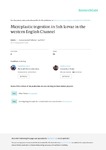Microplastic ingestion in fish larvae in the western English Channel
| dc.contributor.author | Steer, M | |
| dc.contributor.author | Cole, M | |
| dc.contributor.author | Thompson, Richard | |
| dc.contributor.author | Lindeque, PK | |
| dc.date.accessioned | 2017-07-11T12:45:00Z | |
| dc.date.issued | 2017-07 | |
| dc.identifier.issn | 0269-7491 | |
| dc.identifier.issn | 1873-6424 | |
| dc.identifier.uri | http://hdl.handle.net/10026.1/9605 | |
| dc.description.abstract |
Microplastics have been documented in marine environments worldwide, where they pose a potential risk to biota. Environmental interactions between microplastics and lower trophic organisms are poorly understood. Coastal shelf seas are rich in productivity but also experience high levels of microplastic pollution. In these habitats, fish have an important ecological and economic role. In their early life stages, planktonic fish larvae are vulnerable to pollution, environmental stress and predation. Here we assess the occurrence of microplastic ingestion in wild fish larvae. Fish larvae and water samples were taken across three sites (10, 19 and 35 km from shore) in the western English Channel from April to June 2016. We identified 2.9% of fish larvae (n = 347) had ingested microplastics, of which 66% were blue fibres; ingested microfibers closely resembled those identified within water samples. With distance from the coast, larval fish density increased significantly (P < 0.05), while waterborne microplastic concentrations (P < 0.01) and incidence of ingestion decreased. This study provides baseline ecological data illustrating the correlation between waterborne microplastics and the incidence of ingestion in fish larvae. | |
| dc.format.extent | 250-259 | |
| dc.format.medium | Print-Electronic | |
| dc.language | en | |
| dc.language.iso | en | |
| dc.publisher | Elsevier | |
| dc.subject | Plastic debris | |
| dc.subject | Zooplankton | |
| dc.subject | FT-IR | |
| dc.subject | Coastal | |
| dc.subject | Fisheries | |
| dc.title | Microplastic ingestion in fish larvae in the western English Channel | |
| dc.type | journal-article | |
| dc.type | Journal Article | |
| plymouth.author-url | https://www.webofscience.com/api/gateway?GWVersion=2&SrcApp=PARTNER_APP&SrcAuth=LinksAMR&KeyUT=WOS:000405881800027&DestLinkType=FullRecord&DestApp=ALL_WOS&UsrCustomerID=11bb513d99f797142bcfeffcc58ea008 | |
| plymouth.volume | 226 | |
| plymouth.publication-status | Published | |
| plymouth.journal | Environmental Pollution | |
| dc.identifier.doi | 10.1016/j.envpol.2017.03.062 | |
| plymouth.organisational-group | /Plymouth | |
| plymouth.organisational-group | /Plymouth/Faculty of Science and Engineering | |
| plymouth.organisational-group | /Plymouth/Faculty of Science and Engineering/School of Biological and Marine Sciences | |
| plymouth.organisational-group | /Plymouth/REF 2021 Researchers by UoA | |
| plymouth.organisational-group | /Plymouth/REF 2021 Researchers by UoA/UoA07 Earth Systems and Environmental Sciences | |
| plymouth.organisational-group | /Plymouth/Research Groups | |
| plymouth.organisational-group | /Plymouth/Research Groups/Marine Institute | |
| plymouth.organisational-group | /Plymouth/Users by role | |
| plymouth.organisational-group | /Plymouth/Users by role/Academics | |
| plymouth.organisational-group | /Plymouth/Users by role/Researchers in ResearchFish submission | |
| dc.publisher.place | England | |
| dcterms.dateAccepted | 2017-03-26 | |
| dc.rights.embargodate | 2018-4-10 | |
| dc.identifier.eissn | 1873-6424 | |
| dc.rights.embargoperiod | No embargo | |
| rioxxterms.versionofrecord | 10.1016/j.envpol.2017.03.062 | |
| rioxxterms.licenseref.uri | http://www.rioxx.net/licenses/all-rights-reserved | |
| rioxxterms.licenseref.startdate | 2017-07 | |
| rioxxterms.type | Journal Article/Review |


